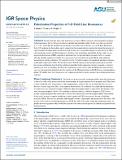Files in this item
Polarization properties of 3-D field line resonances
Item metadata
| dc.contributor.author | Elsden, T. | |
| dc.contributor.author | Wright, A. N. | |
| dc.date.accessioned | 2022-02-15T16:30:15Z | |
| dc.date.available | 2022-02-15T16:30:15Z | |
| dc.date.issued | 2022-02 | |
| dc.identifier | 277722181 | |
| dc.identifier | edd393d9-f50e-4d86-9017-1b38405782f0 | |
| dc.identifier | 85125415148 | |
| dc.identifier | 000765721800024 | |
| dc.identifier.citation | Elsden , T & Wright , A N 2022 , ' Polarization properties of 3-D field line resonances ' , Journal of Geophysical Research: Space Physics , vol. 127 , no. 2 , e2021JA030080 . https://doi.org/10.1029/2021JA030080 | en |
| dc.identifier.issn | 2169-9380 | |
| dc.identifier.other | RIS: urn:E02C29E609D10F590907A6B84F2356E7 | |
| dc.identifier.other | ORCID: /0000-0002-9877-1457/work/108508500 | |
| dc.identifier.other | ORCID: /0000-0002-1910-2010/work/118799812 | |
| dc.identifier.uri | https://hdl.handle.net/10023/24888 | |
| dc.description | T. Elsden is funded by a Leverhulme Trust Early Career Fellowship (ECF-2019-155) and the University of Glasgow. T. Elsden acknowledges previous funding from the University of Leicester. A. Wright was partially funded by the Science and Technology Facilities Council (STFC) grant (ST/N000609/1). The research in this paper was completed as part of the activities of an International Team sponsored by the International Space Science Institute (ISSI, Bern). | en |
| dc.description.abstract | Recent work has shown that field line resonances (FLRs) can form with intermediate magnetic field polarisations, i.e. between toroidal (azimuthal) and poloidal (radial). In this case they are referred to as '3-D', given that the equilibrium and therefore associated wave solutions vary in all three dimensions. Such 3-D variations in the medium can be expected in the magnetosphere in particular during the presence of a plasmaspheric drainage plume in the dusk flank. In this case, strong field-aligned currents driven by FLRs can form along contours of Alfvén frequency which are very asymmetric azimuthally. In this study, we use magnetohydrodynamic (MHD) simulations performed in a background dipole magnetic field, to consider what the satellite signatures would be for a spacecraft observing such non-toroidal FLRs under different magnetopause driving conditions. We consider how the 3-D nature impacts the amplitude and phase relations traditionally expected for FLRs. We find that in the 3-D FLR regions of intermediate polarisation, the FLR has strong contributions from both the radial and azimuthal field components (velocity, magnetic or electric) and these are in or out of phase. We show how hodograms can be used to infer the FLR polarisation in these cases as well as providing predictions for the variation of the FLR polarisation with MLT across a plasmaspheric plume. We further show how the presence of a significant global fast mode can skew the resulting polarisation estimates. | |
| dc.format.extent | 18 | |
| dc.format.extent | 3907759 | |
| dc.format.extent | 3907911 | |
| dc.language.iso | eng | |
| dc.relation.ispartof | Journal of Geophysical Research: Space Physics | en |
| dc.subject | ULF Waves | en |
| dc.subject | MHD Waves | en |
| dc.subject | Magnetosphere | en |
| dc.subject | Field Line Resonance | en |
| dc.subject | Numerical Modelling | en |
| dc.subject | QB Astronomy | en |
| dc.subject | QC Physics | en |
| dc.subject | DAS | en |
| dc.subject.lcc | QB | en |
| dc.subject.lcc | QC | en |
| dc.title | Polarization properties of 3-D field line resonances | en |
| dc.type | Journal article | en |
| dc.contributor.sponsor | Science & Technology Facilities Council | en |
| dc.contributor.institution | University of St Andrews. Applied Mathematics | en |
| dc.identifier.doi | https://doi.org/10.1029/2021JA030080 | |
| dc.description.status | Peer reviewed | en |
| dc.identifier.grantnumber | ST/N000609/1 | en |
This item appears in the following Collection(s)
Items in the St Andrews Research Repository are protected by copyright, with all rights reserved, unless otherwise indicated.


